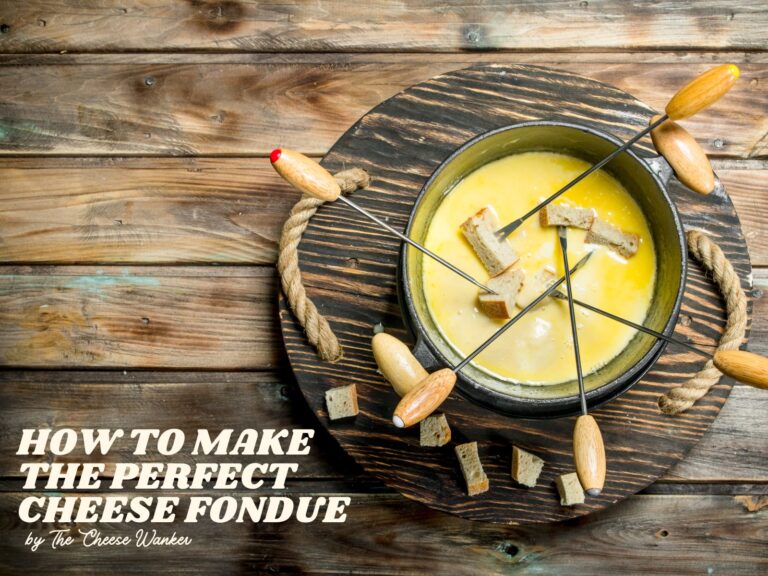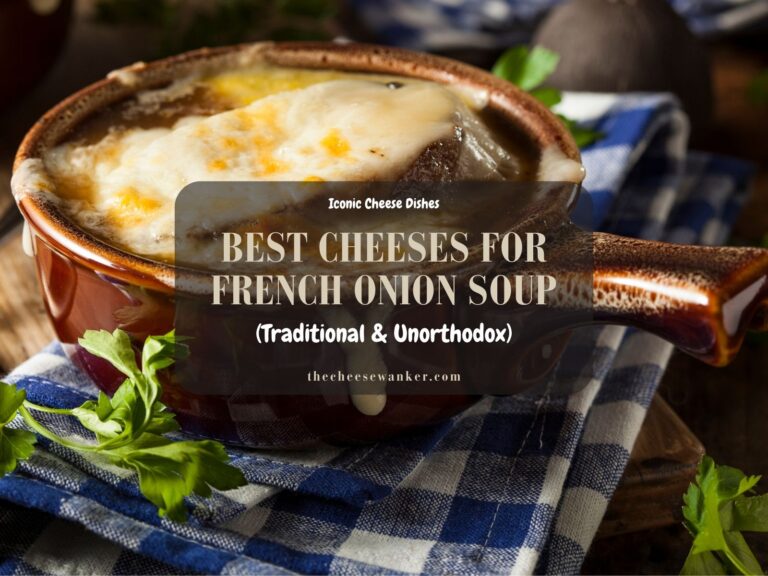Cheese has been an integral part of various cultures’ gastronomy for centuries. From decadent Swiss Fondue to traditional Italian pizzas, cheese-based dishes offer a rich and diverse array of flavours that tantalise taste buds around the world. In this blog post, we embark on a delectable journey to explore some of the most iconic cheese dishes from around the world.
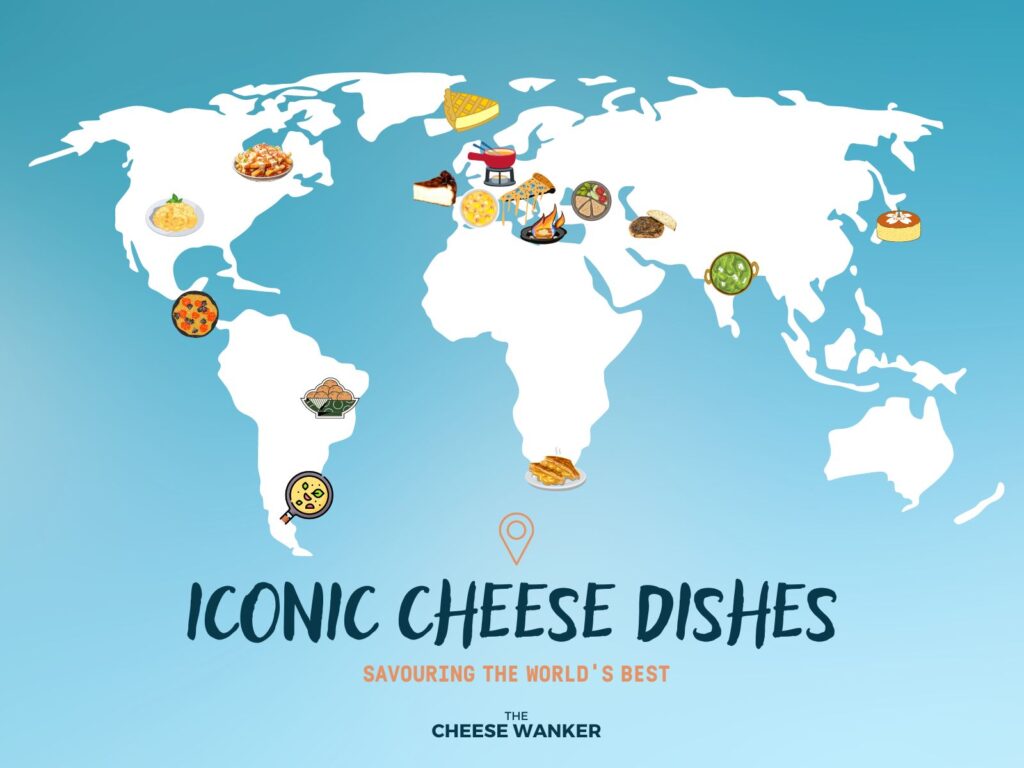
France: Tartiflette & Aligot
Naturally, we begin our journey in the country of 1000 cheeses. Unsurprisingly, French cuisine boasts a myriad of cheese-centred dishes that showcase cheese. Let’s have a look at two of the most iconic French cheese dishes: Tartiflette and Aligot.
Tartiflette
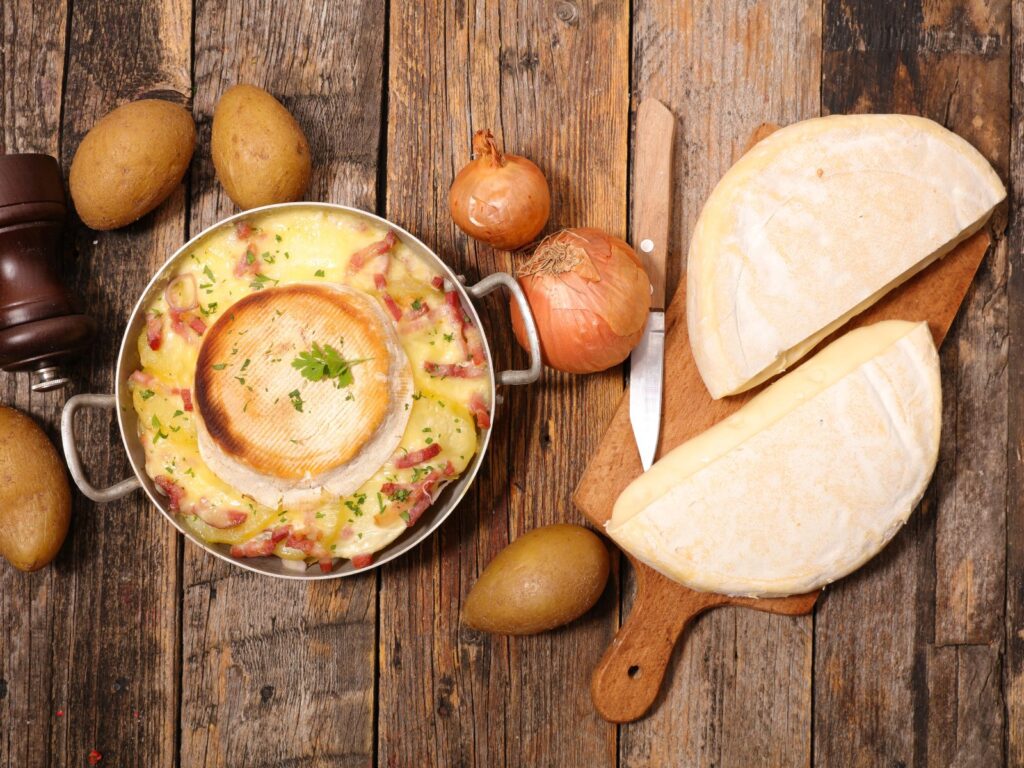
Firstly, Tartiflette is a mouthwatering French dish hailing from the mountain region of Savoie. It is a hearty and indulgent winter staple, starring a pressed uncooked washed rind cheese called Reblochon.
The dish combines sliced boiled potatoes with diced bacon, onions, and crème fraîche, topped with the Reblochon. As it bakes in the oven, the cheese melts into the potatoes, creating a gratin-like dish with a crispy golden crust.
In the Savoie region, the locals serve Tartiflette hot and bubbling. And you can pair it with a crisp green salad and a glass of regional wine. Without a doubt, it embodies the essence of French comfort food.
Aligot
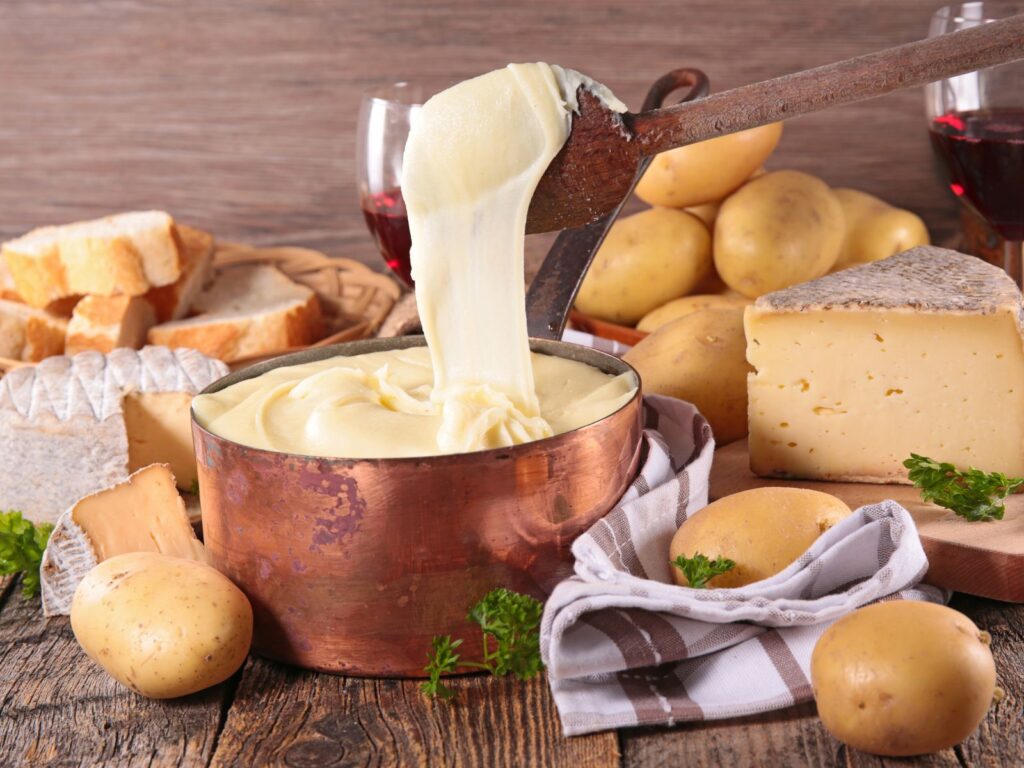
Our second French dish is Aligot which originates from the Cantal and Aveyron departments. Certainly, the star of Aligot is the cheese. Typically, the locals use a young Cantal-like cheese called Tomme de Laguiole.
To make this dish, you cook potatoes, mash them and blend in a melted cheese and cream mixture. Using a rhythmic stirring motion, you create long silky strands of cheese-infused mashed potatoes.
Aligot is traditionally served as an accompaniment to sausages or roasted meats, although its luscious and comforting nature can easily make it a delightful main course.
Italy: Pizza & Salads
Italian cuisine is synonymous with the artful use of cheese in its array of delectable dishes. From melted cheese on a pizza, to fresh Mozzarella in a salad, each region has its own specialty.
Quattro Formaggi Pizza
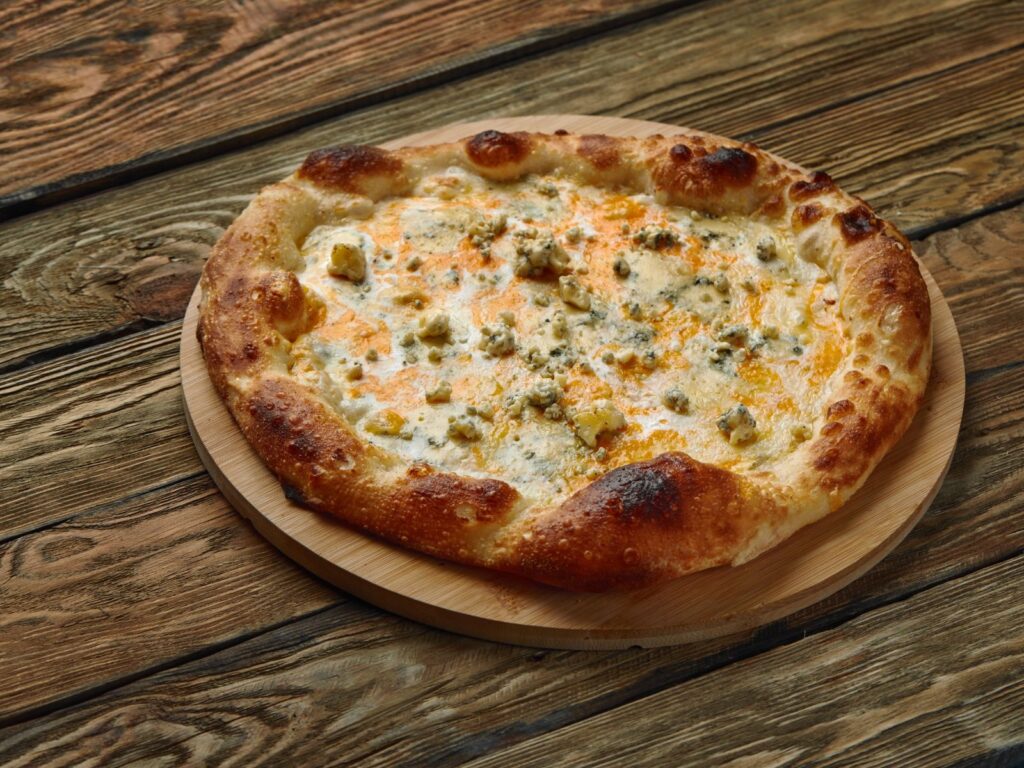
Quattro Formaggi Pizza originated in Italy, and its name translates to “four cheeses.” This flavourful pizza celebrates the love for cheese by combining four distinct varieties: Mozzarella, Gorgonzola, Fontina and Parmigiano Reggiano.
Each cheese contributes its unique taste and texture to the pizza. While Mozzarella adds gooeyness, Gorgonzola contributes tanginess, Fontina nuttiness and Parmigiano Reggiano, fruitiness.
When baked, the cheeses meld together, creating a symphony of flavours that make Quattro Formaggi Pizza a cheese lover’s dream. This pizza is best enjoyed piping hot, with the melted cheese blend covering every slice.
Caprese Salad
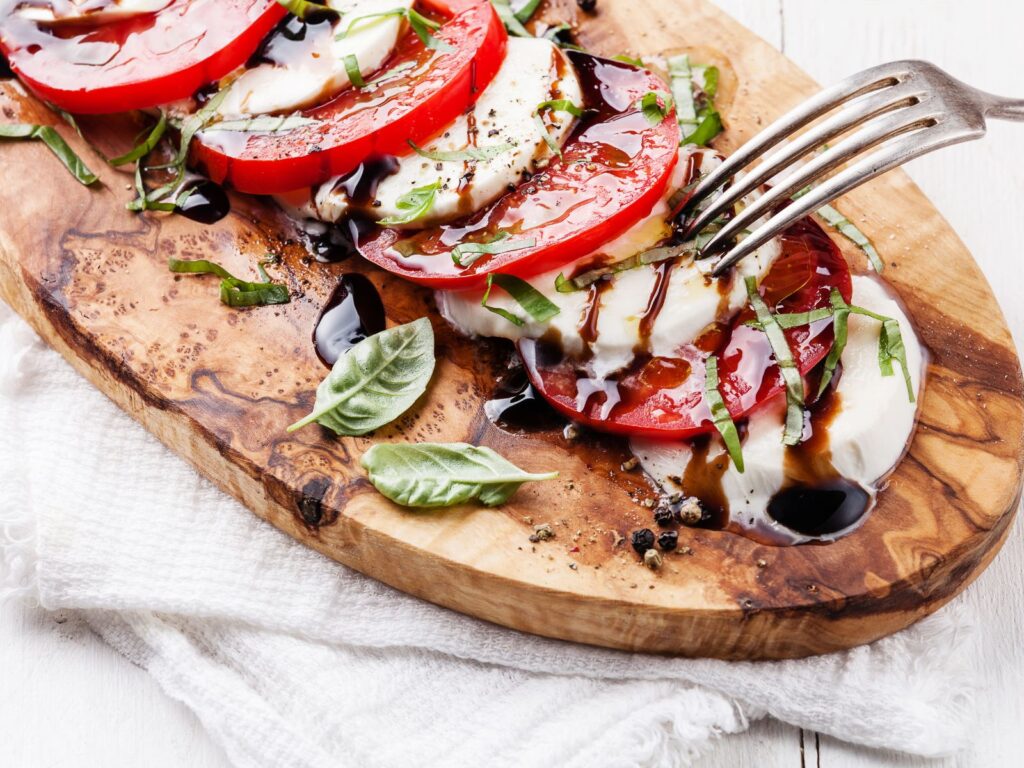
Next, we have an iconic Italian salad. Caprese salad is a classic dish that celebrates simplicity and fresh flavours. Originating from the island of Capri, it comprises just a few key ingredients:
- Ripe tomatoes
- Fresh Mozzarella
- Basil leaves
- Extra-virgin olive oil
- Balsamic vinegar
The combination of sweet tomatoes, creamy Mozzarella and aromatic basil creates a harmonious and refreshing taste. As an added bonus, the Caprese Salad celebrates the Italian flag: red, white and green!
Switzerland: Fondue & Raclette
Switzerland’s cheesemaking prowess is renowned, and iconic dishes like Fondue and Raclette are a testament to this expertise.
Fondue Moitié-Moitié
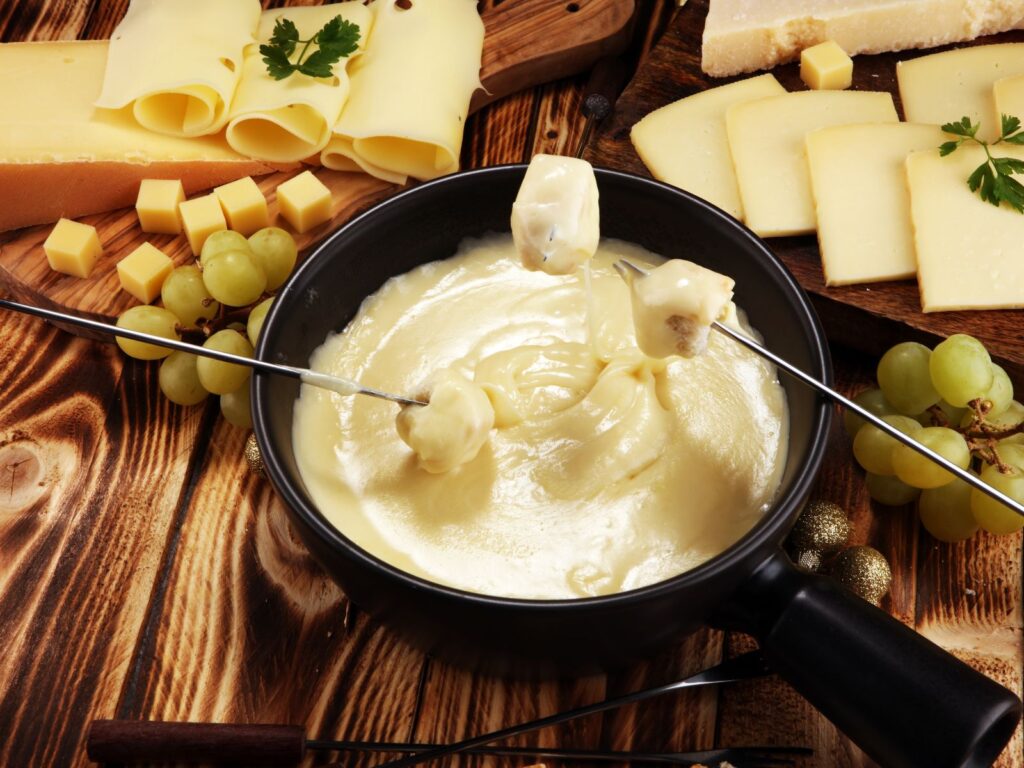
Fondue Moitié-Moitié is a classic Swiss dish that celebrates the art of fondue. Actually, the name “Moitié-Moitié” translates to “half-half,” referring to the two main cheeses used in this traditional recipe.
To make Fondue Moitié-Moitié, you use two famous Swiss cheeses, Gruyère and Vacherin Fribourgeois. After grating the cheese, you add in with garlic and white wine to create a smooth and velvety fondue base.
The cheese mixture is then placed in a fondue pot and warmed over a low flame, where it slowly melts into a creamy and indulgent concoction. Undoubtedly, Fondue Moitié-Moitié is best enjoyed when around the fondue pot, dipping bite-sized pieces of crusty bread into the molten cheese.
Raclette
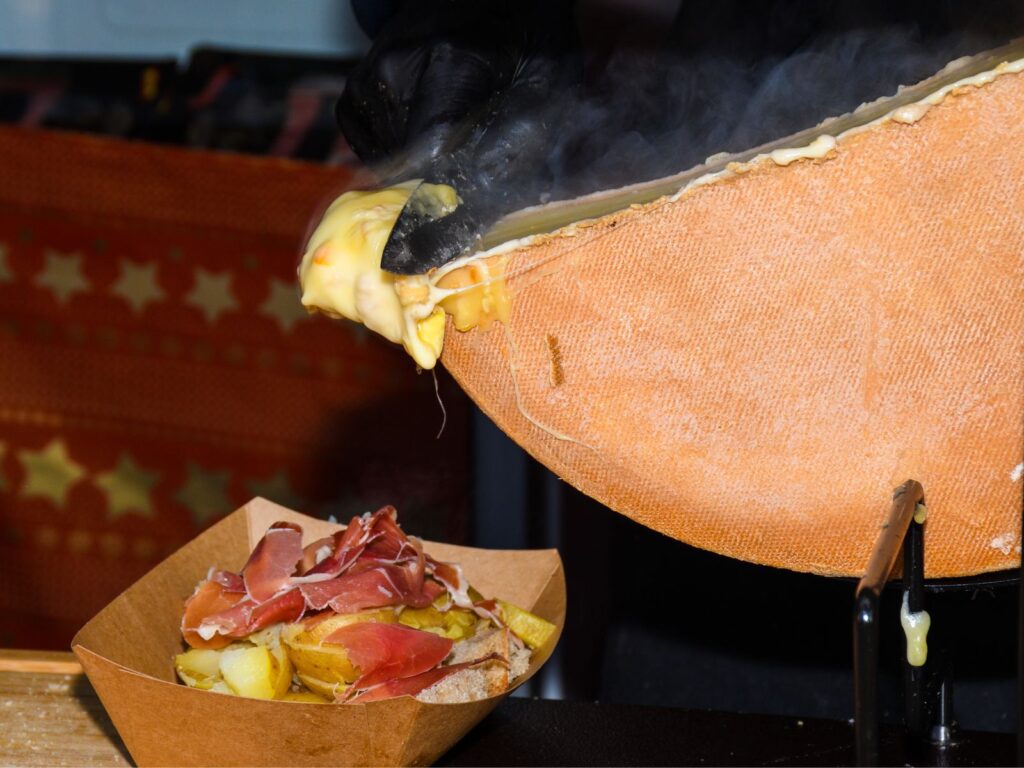
Our second Swiss dish is Raclette. This beloved cheesy Swiss dish originates from the Swiss Alps and showcases the country’s rich cheesemaking heritage and culinary traditions.
Of course, the star ingredient is Raclette cheese, made from cow’s milk and known for its smooth, creamy texture and nutty flavour. To serve, a large wheel of Raclette cheese is heated, and the melted layer is scraped onto individual plates.
The most common accompaniments for Raclette are boiled potatoes, gherkins, pickled onions and cured meats.
Austria: Käsespätzle
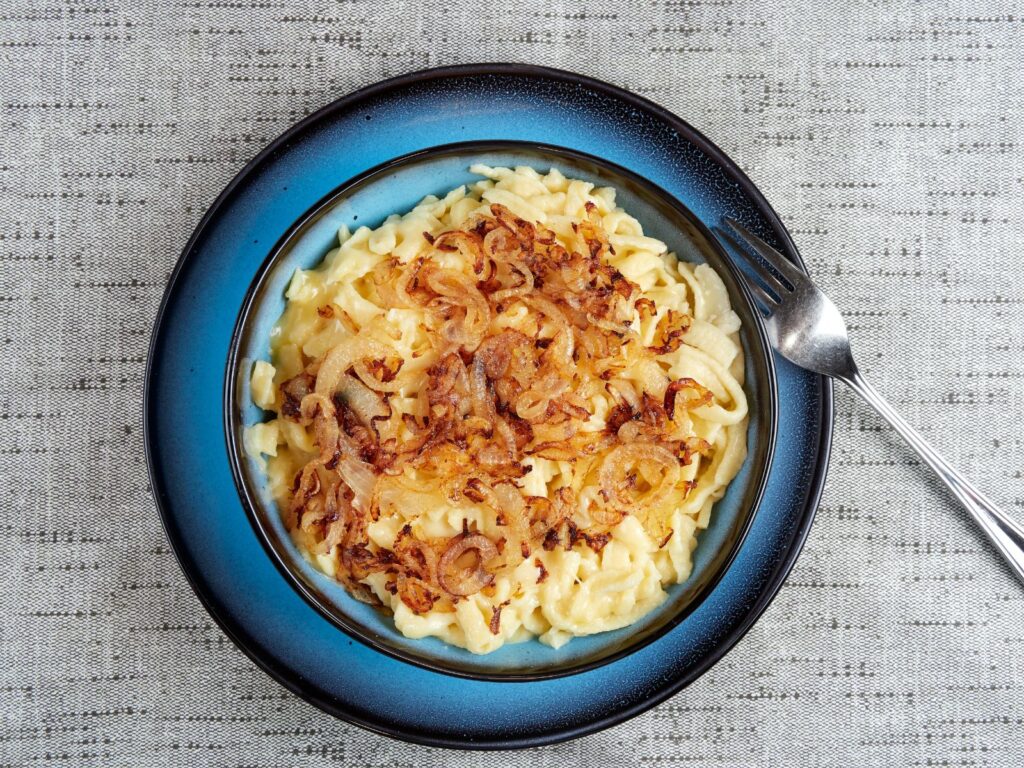
Sharing borders with Switzerland and Italy, we find Austria. This picturesque land-locked nation boasts a rich culinary tradition. And our chosen dish for this blog post is Käsespätzle.
Käsespätzle is a classic comfort food has become an iconic symbol of Austrian cuisine. The main ingredient of this warming dish is the spätzle itself – soft, chewy egg noodles. But the cheese sauce that blankets the spätzle is what truly sets this dish apart.
The most common cheese used is Emmentaler, but other varieties like Gruyère or Bergkäse are also popular. Traditionally, Käsespätzle is served in small wooden bowls or cast-iron skillets. Unsurprisingly, this soul-soothing dish is perfect for chilly days in the Alps.
Spain: San Sebastián Cheesecake
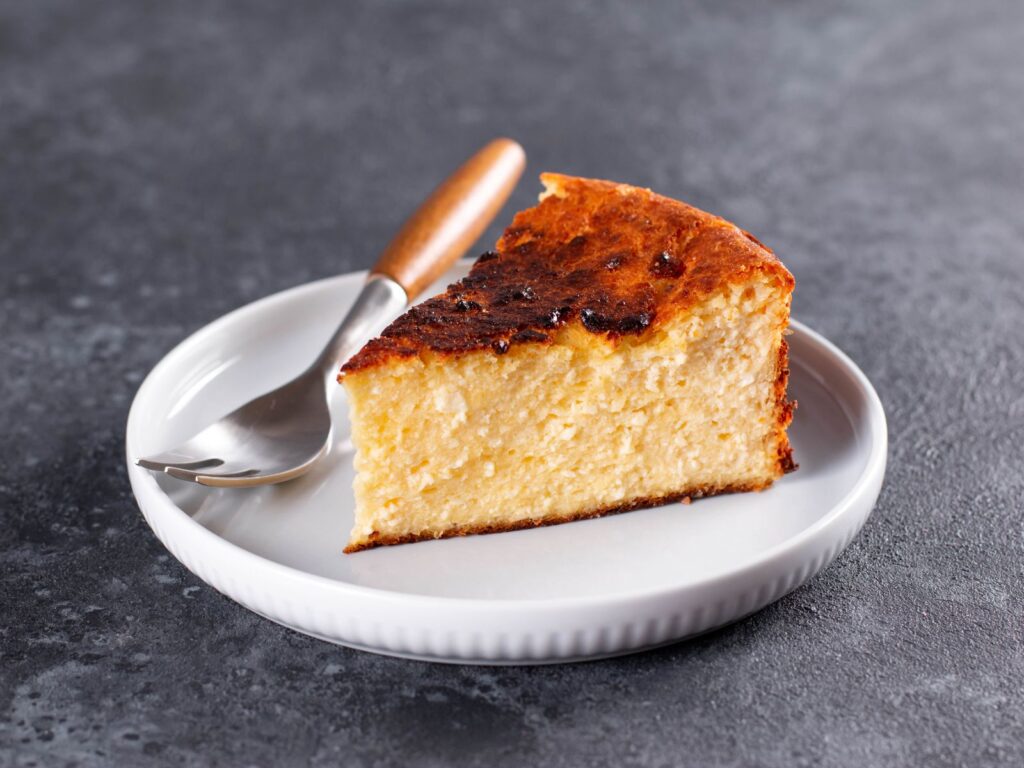
Also known as “Burnt Basque Cheesecake”, this luscious dessert hails from the Basque region of Spain. The cheesecake owes its signature look to its unique burnt exterior, which results from baking the cake at a high temperature.
The batter is made with Cream Cheese, eggs, sugar and heavy cream. Since it has no crust, this cheesecake has a striking rustic appearance. As it bakes, the cake develops a beautiful caramelised top and edges while remaining creamy and slightly jiggly inside.
San Sebastián Cheesecake is loved for its creamy and rich flavour, with a subtle hint of caramelization. Moreover, its minimalist preparation and unforgettable taste have made it a favourite in Spain and beyond.
Greece: Spanakopita & Saganaki
In Greece, cheese holds a significant place in its culinary culture. With a grand total of 21 PDO cheeses, this is not surprising. Narrowing down our selection of Greek dishes was not easy. But for this post, we’re going to tell you about Spanakopita and Saganaki.
Spanakopita
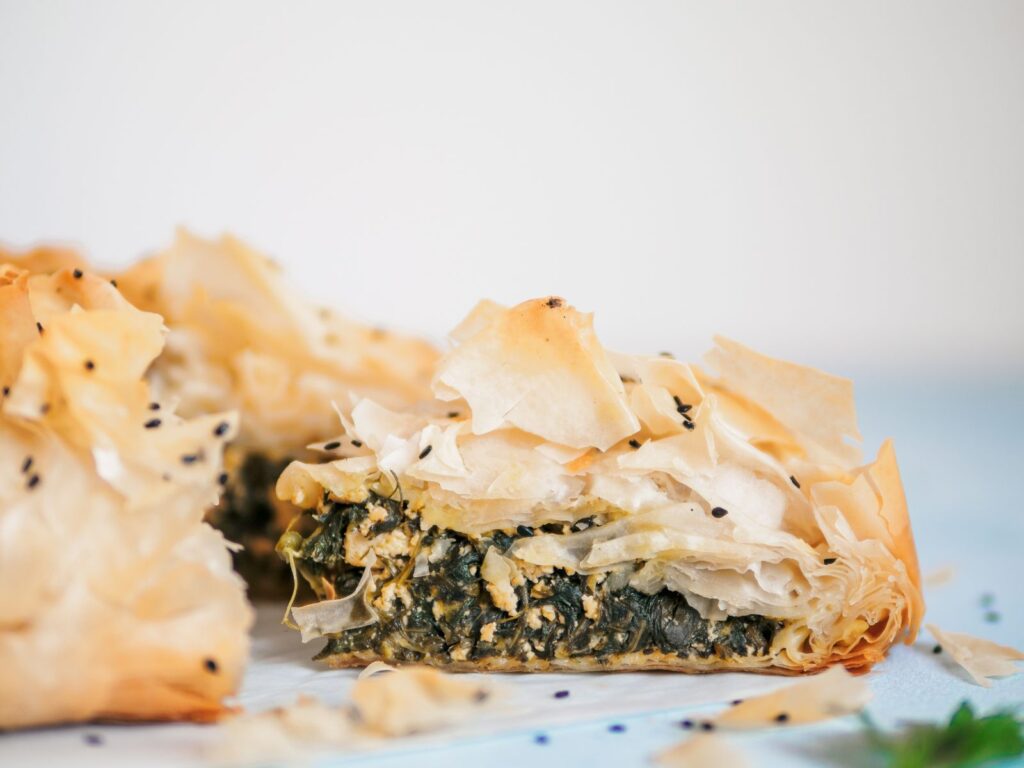
Spanakopita is a pastry dish that celebrates the harmonious marriage of spinach and Feta cheese. The name “Spanakopita” is derived from the Greek words “spanaki” (spinach) and “pita” (pie), reflecting the dish’s core ingredients.
In addition to those two ingredients, most versions of Spanakopita also contain onions, dill and parsley. The filling is encased in layers of flaky phyllo pastry, with each layer brushed generously with olive oil or melted butter.
Once baked, Spanakopita emerges golden and crispy, with a delightful medley of flavours. This savoury pie is a popular starter or main course, playfully blending the flaky pastry and soft cheesy spinach filling.
Saganaki
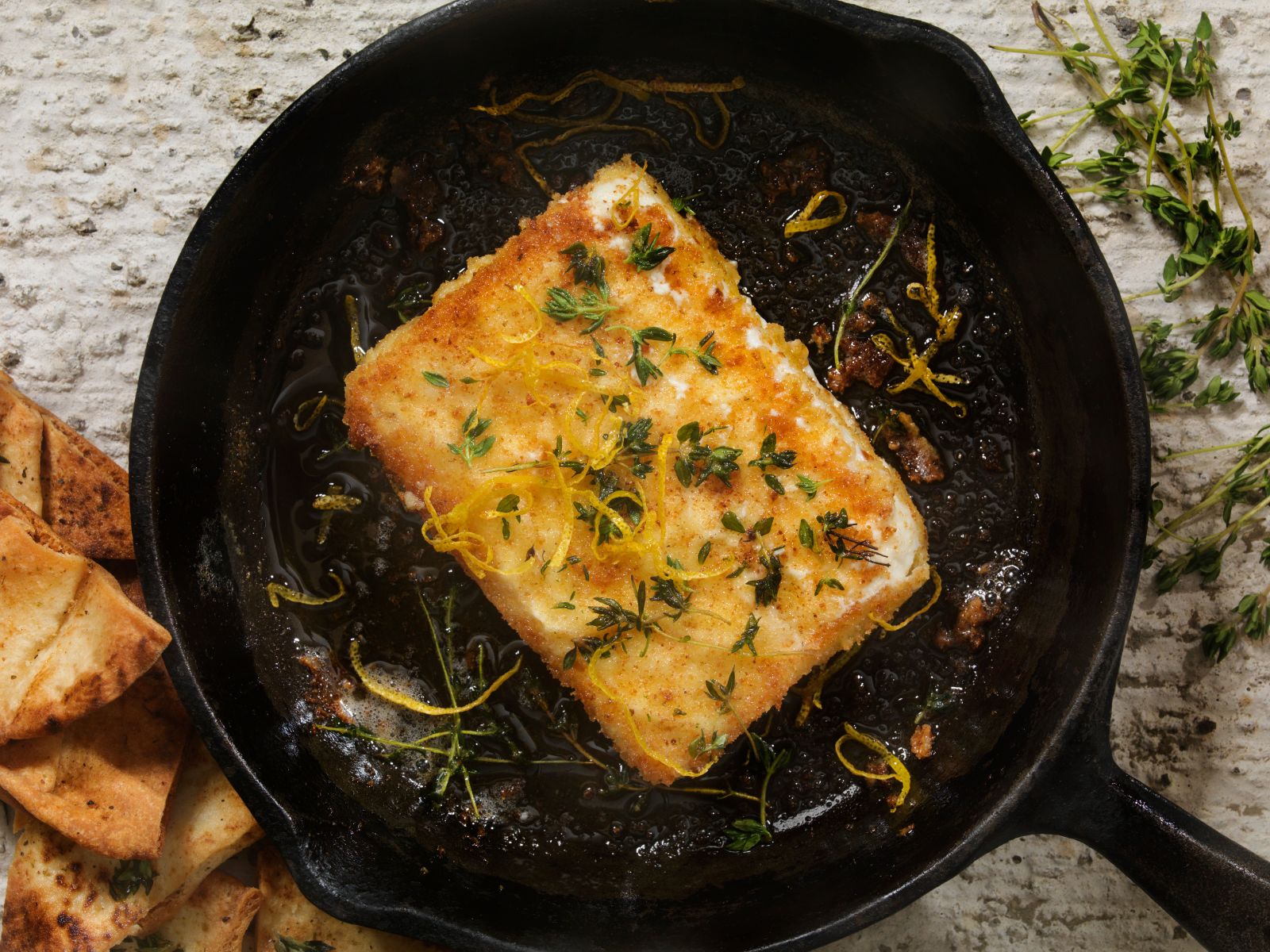
Next, we have Saganaki. This decadent Greek dish showcases the magic of frying cheese to perfection. As a matter of fact, the name “saganaki” refers to the small frying pan in which the dish is traditionally prepared.
Traditionally, the locals use firm Greek cheeses, like Kefalograviera or Kasseri to make Saganaki. The cheese is lightly coated in flour and pan-fried until it develops a crispy and golden crust.
Often served flambéed with a splash of brandy or ouzo, the cheese takes on a delightful aromatic kick. Besides, the dish is often drizzled with fresh lemon juice before serving, enhancing its tanginess.
We’ve got a complete guide to Saganaki here if you want to learn more about the different cheeses you can use.
Sweden: Västerbottenpaj
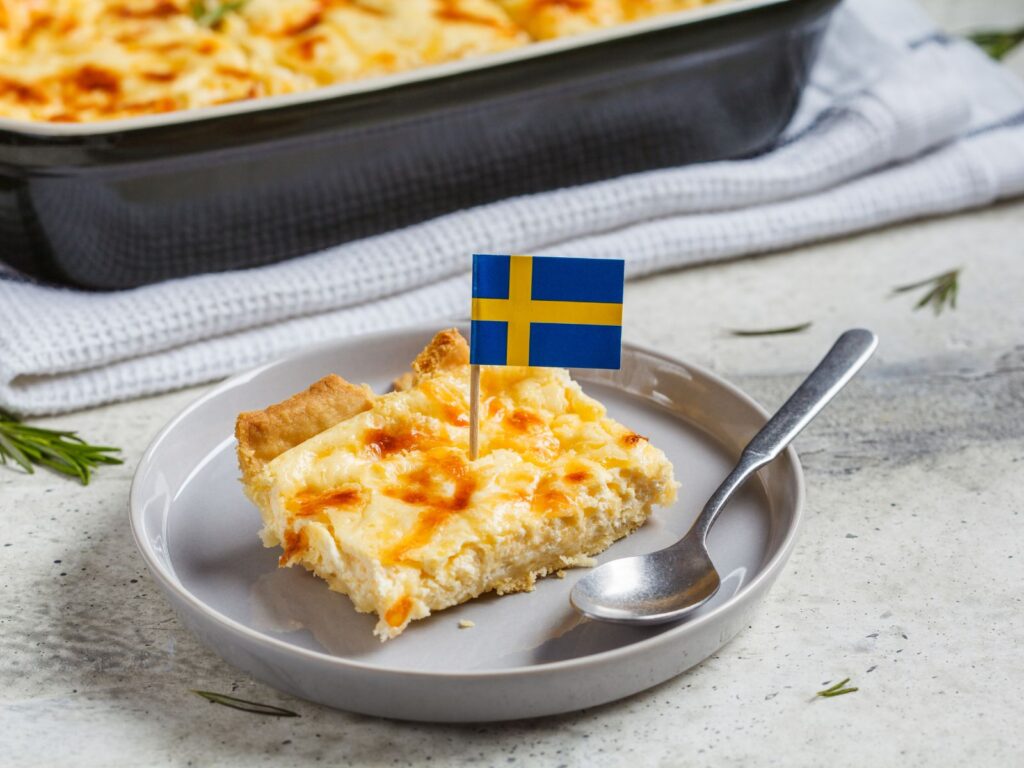
Our final stop in Europe is in Scandinavia. Västerbottenpaj (or Västerbotten Cheese Pie) is a beloved and iconic dish hailing from the Västerbotten region in northern Sweden. The star ingredient is Västerbotten cheese, a distinct and flavourful cheese known for its granular texture and nutty taste.
Västerbotten Cheese Pie is traditionally made with a buttery pastry crust and a filling of grated cheese, eggs and cream. As it bakes, the pie develops a golden and crispy top while the cheese filling becomes rich and creamy.
The Swedes serve Västerbottenpaj both as an appetizer and a side dish. Moreover, it is a popular dish at celebratory gatherings, holiday feasts and Swedish Midsummer festivities.
Mexico: Queso Flameado
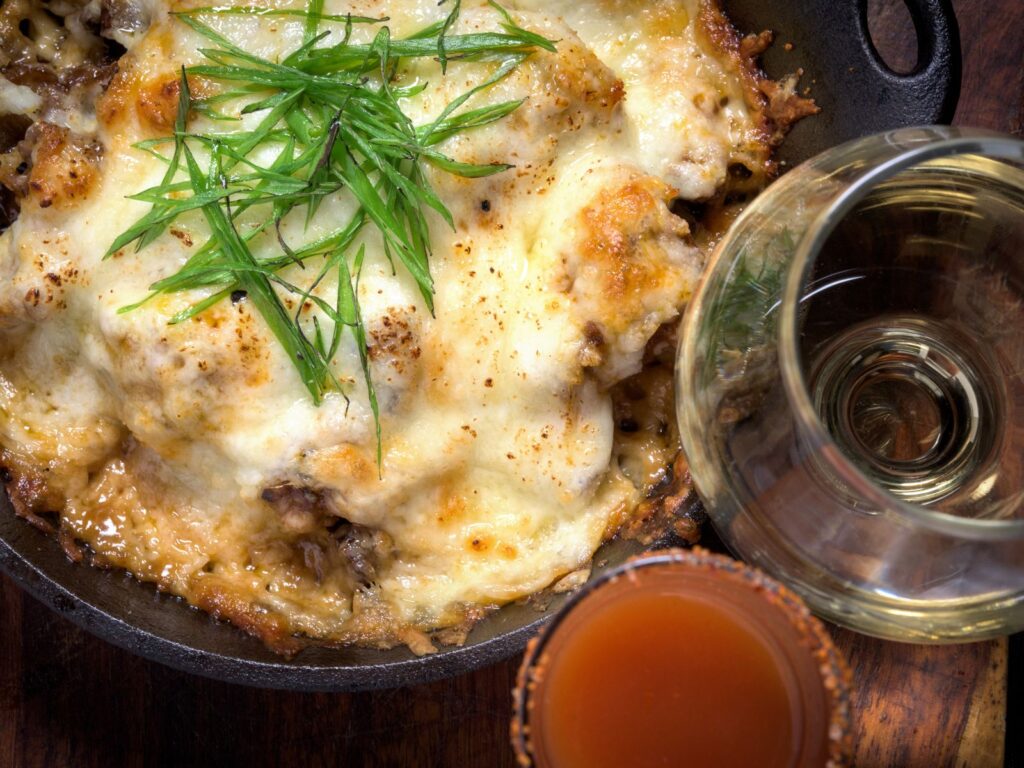
Mexico is a country known for its vibrant colours and flavours. And one dish that stands out for its cheesy goodness and spectacular presentation is Queso Flameado.
Queso Flameado is a sizzling Mexican dish that showcases the joy of melted cheese and flavoursome ingredients. The star of this dish is typically a blend of melted cheeses, such as Oaxaca and/or Asadero, combined with ingredients like chorizo and poblano peppers.
Served with warm tortillas, Queso Flameado offers a rich cheesy experience that celebrates the dynamic flavours of Mexican cuisine.
United States: Macaroni & Cheese
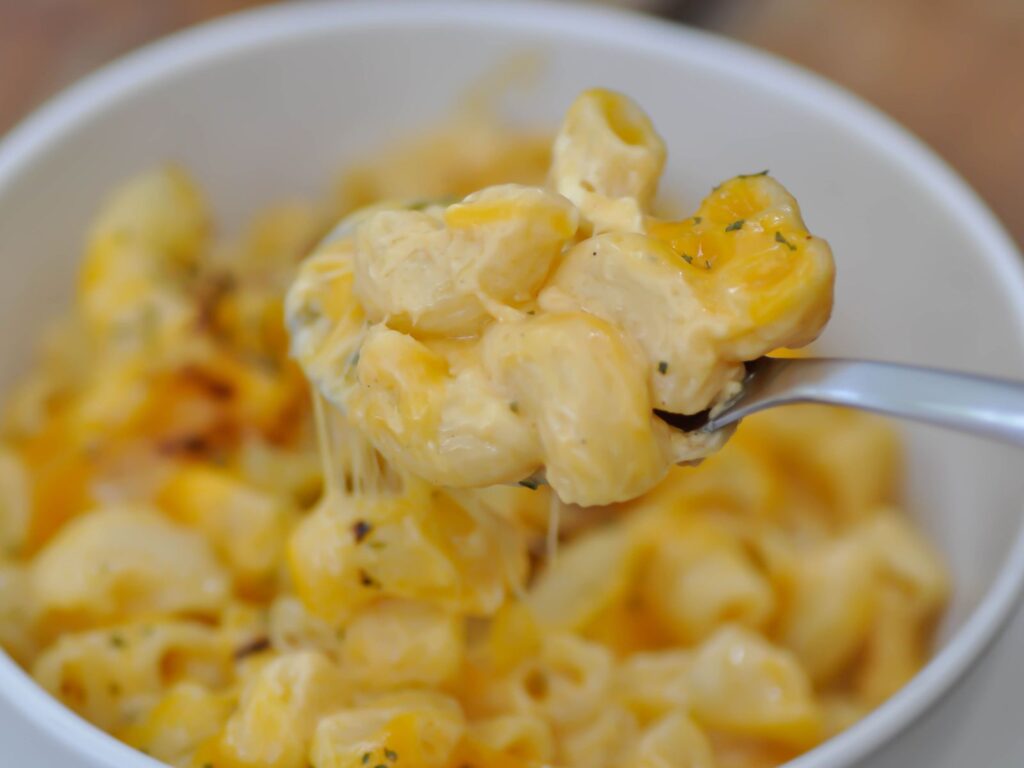
Traveling north from Mexico, we find ourselves in the United States of America, the birthplace of Macaroni & Cheese.
Nowadays, Mac & Cheese is a comfort food enjoyed around the world. The dish consists of cooked macaroni pasta mixed with a creamy cheese sauce. The sauce is typically made by combining butter, flour, milk, and shredded cheese. The most common cheeses used include Cheddar and Monterey Jack, to create a velvety mixture. Some variations may include breadcrumbs on top for added texture and a golden crust when baked.
You can find out which cheeses work best in Macaroni & Cheese by reading our dedicated post here.
Canada: Poutine
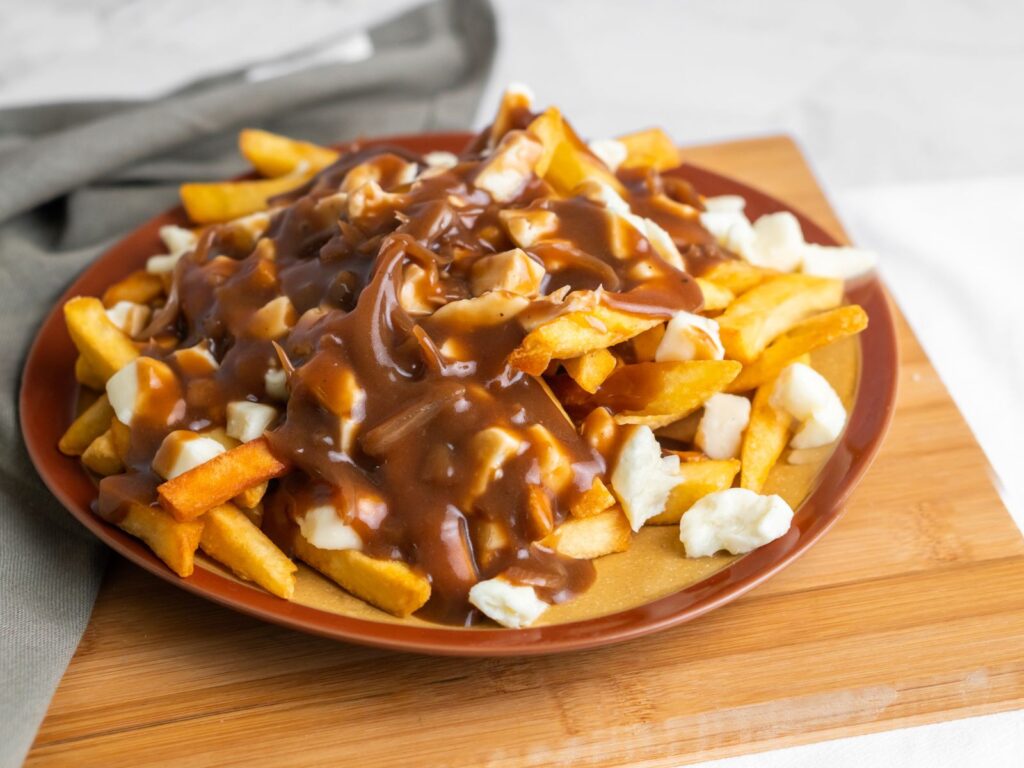
Continuing our journey north, we cross the border into Canada. And there is one cheesy dish that completely dominates the local landscape: Poutine.
Poutine is a beloved Canadian dish that has gained popularity both within the country and internationally. Originating in Québec, Poutine is an unorthodox combination of crispy French fries, cheese curds, and rich gravy.
The dish’s signature ingredient is fresh cheese curds. The chunky and squeaky curds provide a delightful contrast to the hot fries and savoury gravy. Furthermore, you can customise your Poutine with additional toppings, such as pulled pork or smoked meat.
This indulgent and comforting dish has become a symbol of Canadian culinary pride and is perfect for satisfying late-night cravings.
Brazil: Pão de Queijo
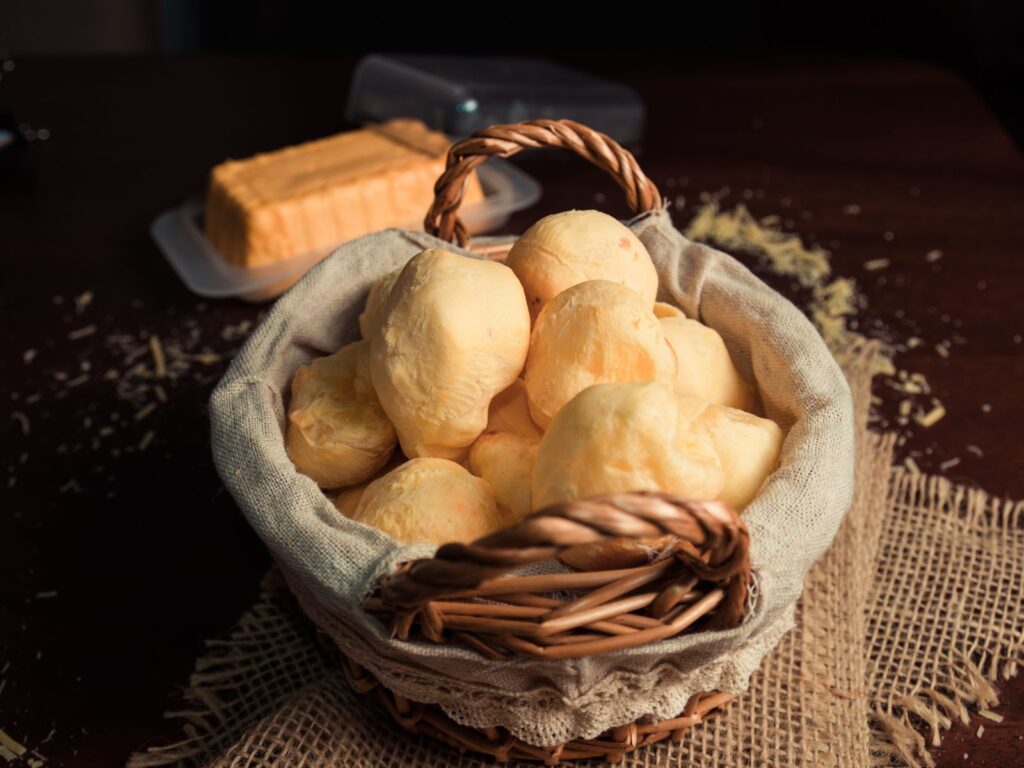
Being a vibrant land of diverse cultures, Brazil offers a delightful array of traditional dishes that celebrate cheese. And the most famous one might just be Pão de Queijo.
Also known as Brazilian Cheese Bread, Pão de Queijo is a beloved local snack made. The traditional ingredients are tapioca flour, eggs, milk and cheese. While modern versions may use Mozzarella or Parmesan, traditional Pão de Queijo is made with the local Minas cheese. The small balls are puffy and golden on the outside, while remaining soft and cheesy on the inside.
These delightful cheese bread balls are popular throughout Brazil and are often enjoyed as a breakfast item or as a snack.
Argentina: Provoleta
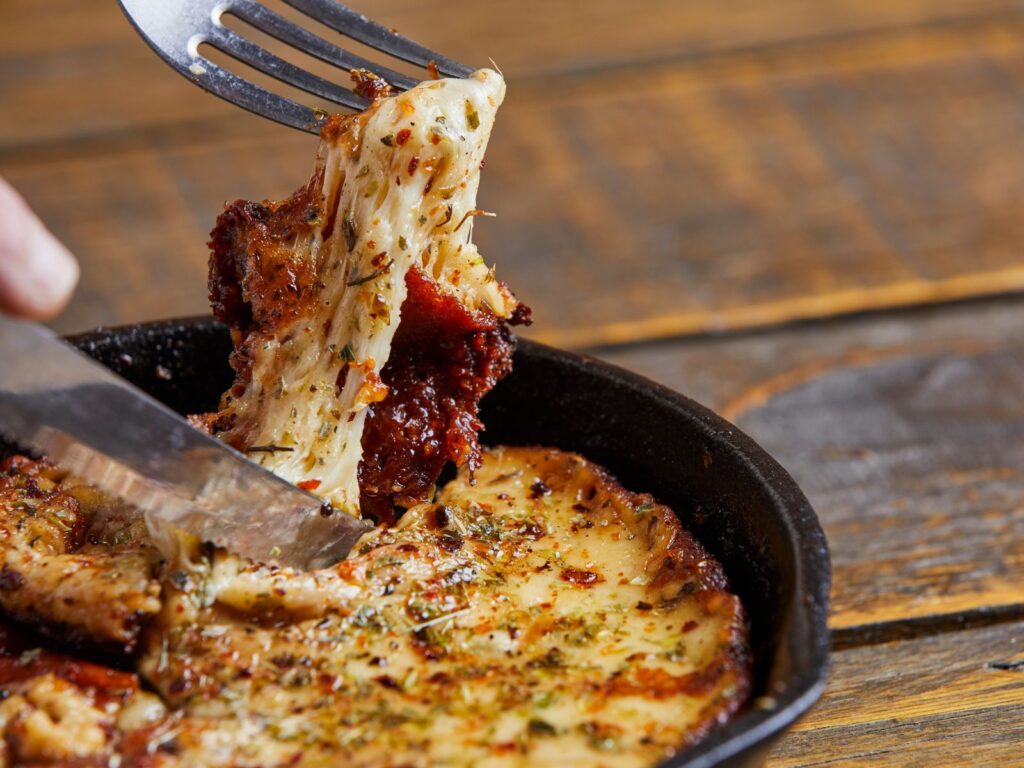
Our next destination is also in South America. Without a doubt, Argentina is renowned for its love of meat and grilling traditions. Hence, it should be of no surprise that our highlighted dish is Provoleta.
Provoleta is a simple dish that highlights the irresistible combination of melted cheese and the flavours of the grill. Of course, the star of Provoleta is the cheese itself – typically a slice of Provolone cheese.
To prepare Provoleta, the cheese is seasoned with herbs and red pepper flakes, and drizzled with olive oil. The seasoned cheese slice is then grilled on an open flame until it develops a crisp and slightly charred crust.
Provoleta is often served hot and sizzling, straight from the grill. The warm and velvety cheese is typically accompanied by a side of crusty bread or a simple salad.
Turkey: Peynirli Gözleme
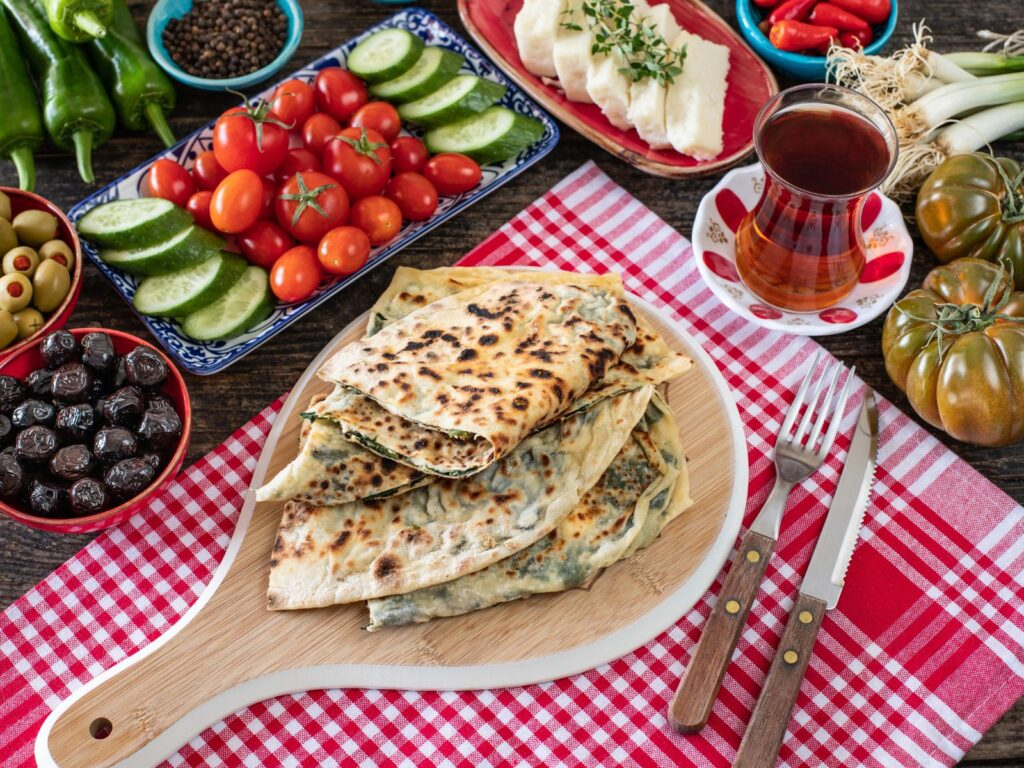
After our detour through the Americas, we’re back in Europe. Turkey is a country at the crossroads of continents. As such, its gastronomic heritage brings together East and West. This unique marriage is highlighted in an array of dishes bringing together cheese and local spices. One such beloved and versatile dish is Peynirli Gözleme.
Peynirli Gözleme is a savoury stuffed flatbread that has its roots in Anatolian villages. And most traditional versions showcase a white pressed Turkish cheese called Beyaz Peynir.
Its portability and mouth-watering taste make it an excellent snack or meal option. So, don’t be surprised if you find this flatbread at every corner stall in the local food markets.
Syria: Manakeesh
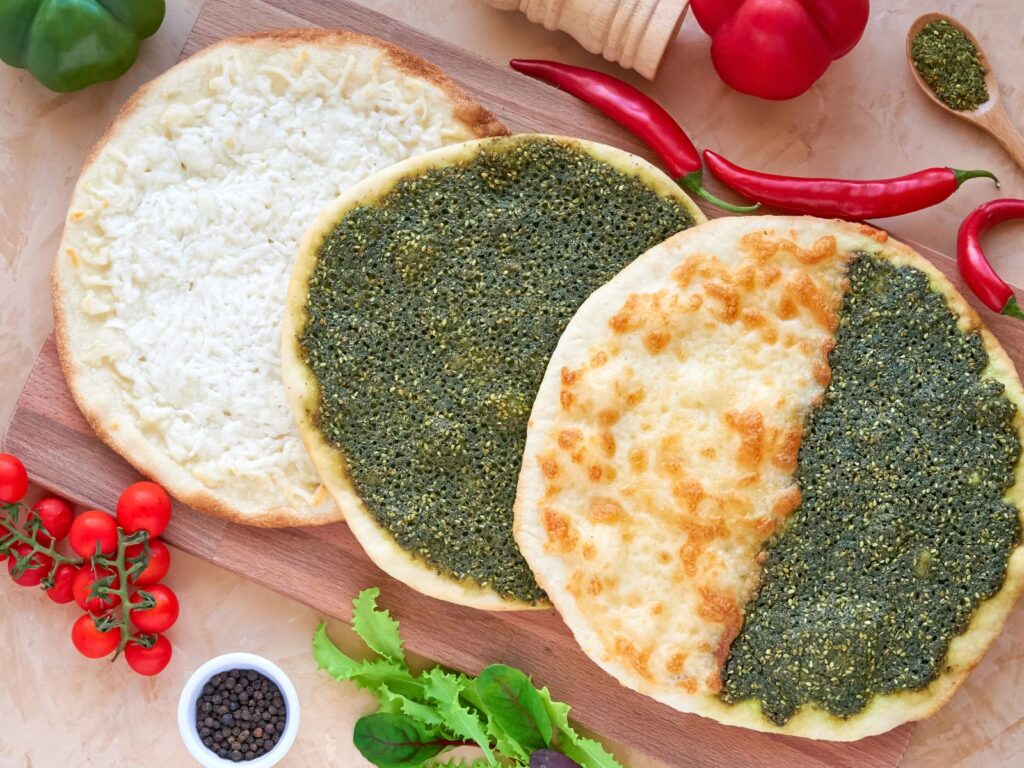
As we venture into Asia, we make a quick stop in Syria. This Levantine nation is the birthplace of another dish that celebrates cheese and bread: Manakeesh.
Manakeesh, also known as “Manakish” or “Manousheh,” is a beloved Levantine dish with ancient roots. One popular variation of this bread features Akkawi cheese as the main topping. In addition to the cheese, the locals also use za’atar (a blend of herbs and spices) and olive oil. The Akkawi cheese imparts a creamy and savoury taste that complements the aromatic flavours of za’atar.
Manakeesh is enjoyed both as a breakfast dish and as a snack throughout the day. Moreover, it is often served warm, cut into slices, and rolled or folded. Therefore, it is a convenient and flavourful on-the-go meal in the bustling streets of Syria.
India: Palak Paneer
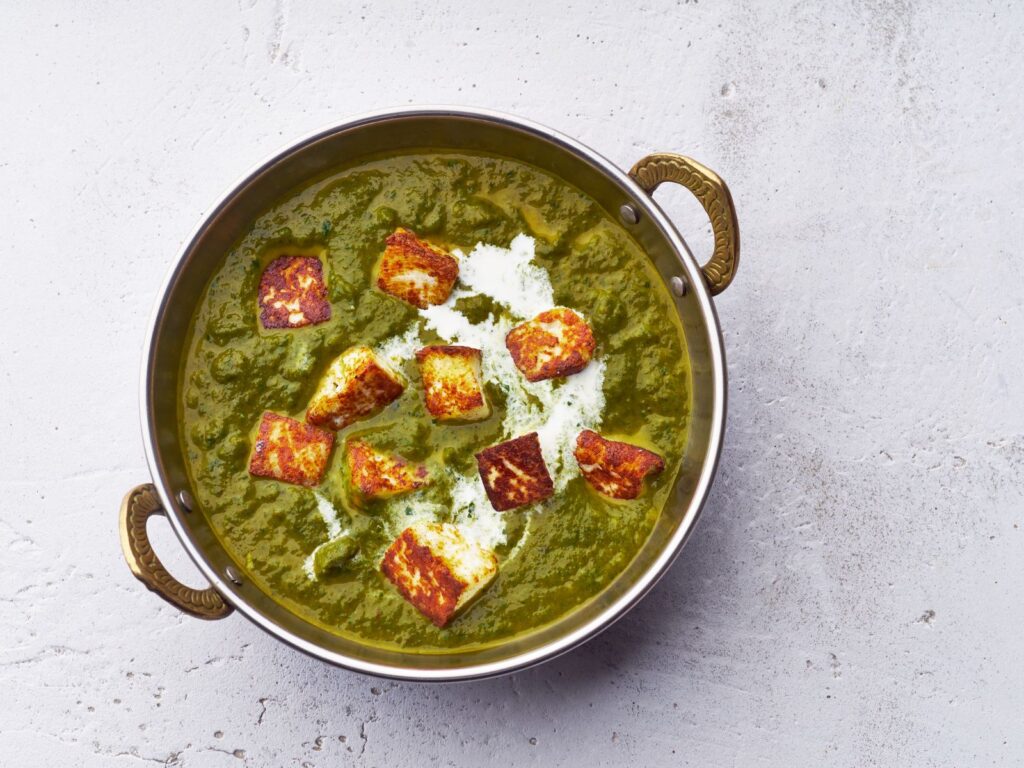
With its diverse cultures and vibrant flavours, Indian cuisine offers a plethora of iconic cheese dishes. One such cherished culinary masterpiece is Palak Paneer.
Palak Paneer is a luscious and wholesome vegetarian dish that combines the earthiness of spinach (palak) with the creamy goodness of Paneer, a fresh Indian cheese.
To prepare Palak Paneer, cubes of Paneer are lightly fried until golden, adding a hint of crispiness to the otherwise tender cheese. The creamy spinach gravy, made with blanched spinach leaves and a medley of aromatic spices, is then added to the fried Paneer.
Whether you enjoy it at a bustling street food stall or at the dinner table of a traditional Indian home, Palak Paneer encapsulates the essence of Indian culinary artistry. And the beautiful union of cheese and vegetables exemplifies the rich tapestry of Indian flavours.
Japan: Soufflé Cheesecake
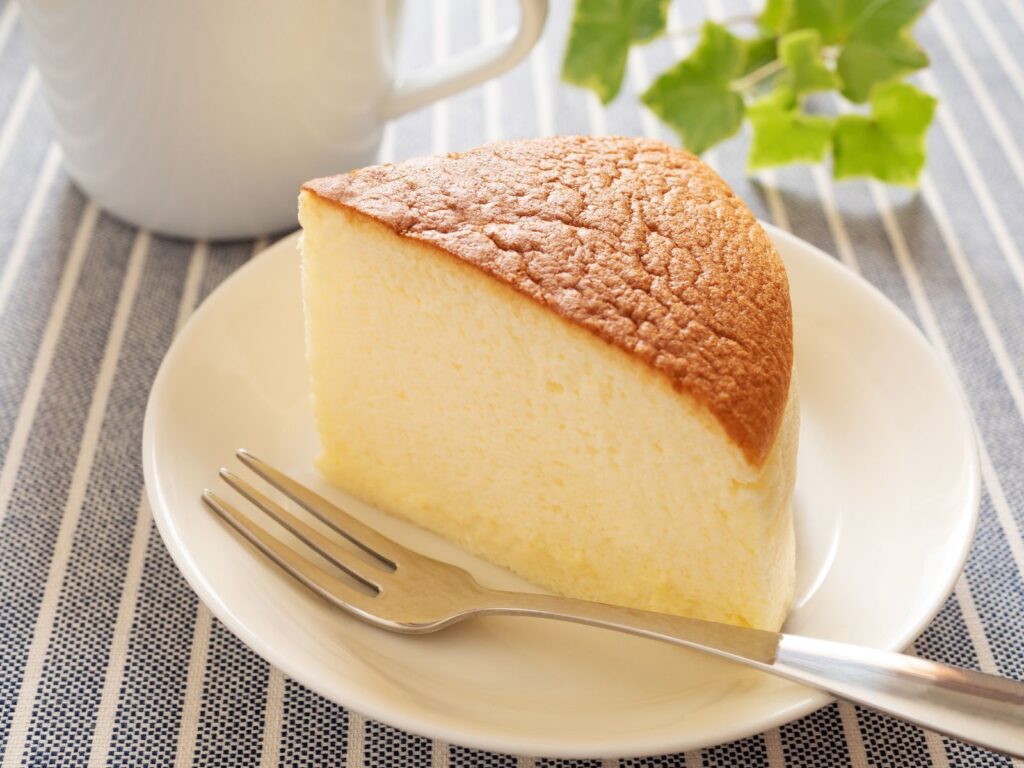
Japanese Cheesecake, also known as “Soufflé Cheesecake”, is a delightful and fluffy dessert that has gained popularity worldwide. Originating from Japan, this unique cheesecake offers a lighter and airier texture compared to traditional cheesecakes.
To create Japanese Cheesecake, you make a batter is using Cream Cheese, egg yolks, sugar and milk. Baked in a water bath, it emerges with a delicate, soufflé-like appearance.
Overall, this unique cheesecake has a mild and creamy flavour, making it a popular treat for teatime and special occasions.
South Africa: Braaibroodjies
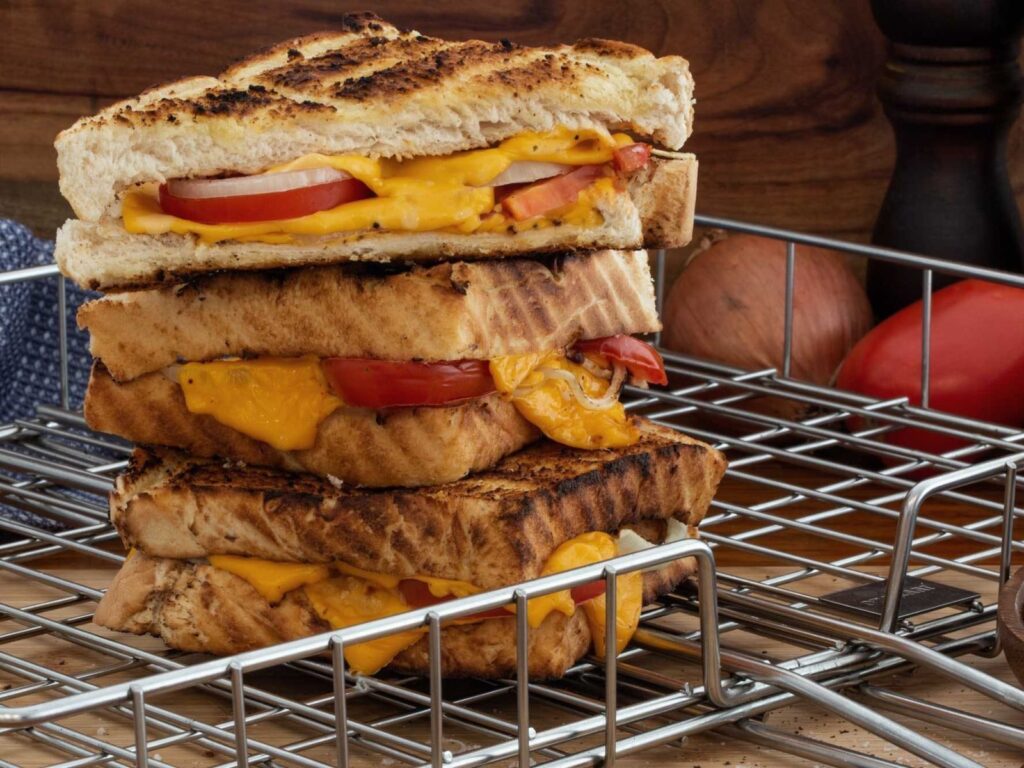
Our final cheese dish comes from the African continent. South Africa is a country renowned for its vibrant culture and diverse culinary traditions. And one dish that perfectly embodies the spirit of South African outdoor gatherings and braais (barbecues) is the Braaibroodjie.
This delightful grilled sandwich is a beloved staple at braais across the nation, cherished for its simplicity and mouthwatering flavours.
Braaibroodjie starts with slices of buttered bread, often accompanied by a layer of tomato and onion. The latter add a burst of freshness and juiciness to the sandwich. However, the star of this dish is undoubtedly the cheese, usually Cheddar or Gouda, which generously fills the sandwich.
As the sandwich grills over the open flames, the cheese becomes perfectly molten, oozing out from the sides and enveloping the other ingredients in a blanket of creaminess.
Summary: Cheese is more than just an ingredient
This culinary journey has taken us around the globe, exploring the delightful world of cheese dishes from different cultures. From France to South Africa, each dish showcases the unique ways in which cheese can take centre stage.
Beyond being a mere ingredient, cheese holds cultural significance, symbolising togetherness and celebration. Hence, each cheese dish reflects its respective culture, representing the historical and geographical nuances of the region.
What are your favourite cheese dishes? Leave us a comment below to keep the conversation going.
